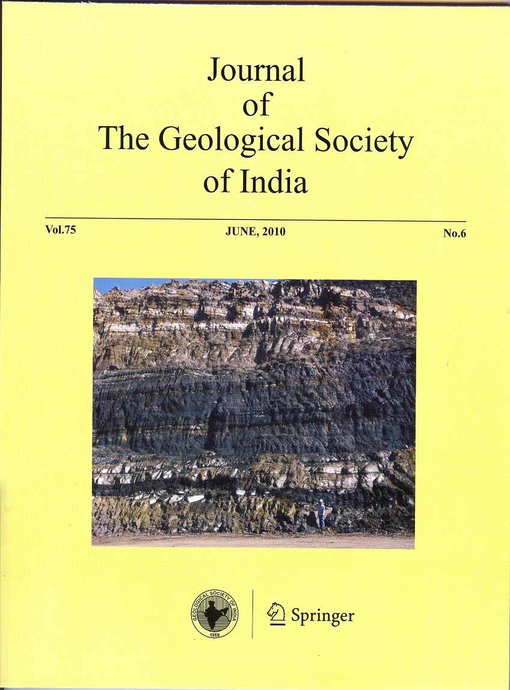New Legume Fruits from the Oligocene Sediments of Assam
Keywords:
Fabaceae, Late Oligocene, <i>Butea, Leguminocarpon</i>, Palaeoecology, Assam.Abstract
For the first time a rich assemblage of legume fruits is described from the Late Oligocene sediments of the Makum as well as Dilli-Jeypore coalfields of Assam. A new genus Buteocarpon has been instituted for the fossil fruits resembling Butea Roxb. of the family Fabaceae. In addition, six new species of the genus Leguminocarpon Goeppert are also described. Their presence indicates a warm and humid climate in the region during the deposition of the sediments.Downloads
Issue
Section
Downloads
Published
How to Cite
References
ANTAL, J.S. and AWASTHI, N. (1994) Fossil flora from the Himalayan foot-hills of Darjeeling District, West Bengal and its palaeoecological and phytogeographical significance. Palaeobotanist, v.42, pp.14-60.
AWASTHI, N. and MEHROTRA, R.C. (1995) Oligocene flora from Makum Coalfield, Assam, India. Palaeobotanist, v.44, pp.157188.
AWASTHI, N. and PRASAD, M. (1990) Siwalik plant fossils from Surai Khola area, western Nepal. Palaeobotanist, v.38, pp.298318.
BANERJI, J. (2000) Occurrence of angiosperm remains in an Early Cretaceous intertrappean bed, Rajmahal basin, India. Cretaceous Res., v.21, pp.781-784.
BHATTACHARYYA, B. (1985) Leguminous fruits from the Eocene of Garo Hills, Meghalaya. Quart. Jour. Geol. Min. Met. Soc. India, v.57, pp.215-225.
CALVILLO-CANADELL, L. and CEVALLOS-FERRIZ, S.R.S. (2005) Diverse assemblage of Eocene and Oligocene Leguminosae from Mexico. Internat. Jour. Plant Sci., v.166, pp.671-692.
GOEPPERT, H.R. (1855) Die Tertiara flora von Schossnitz in Schlesien. Gorlitz.
GULERIA, J.S., HEMANTA SINGH, R.K., MEHROTRA, R.C., SOIBAM, I. and KISHOR, R. (2005) Palaeogene plant fossils of Manipur and their palaeoecological significance. Palaeobotanist, v.54, pp.67-77.
HEER, O. (1859) Die tertiara flora der Schweiz. flora Tertiaria Helvetiae. Winterthur. v.3, pp. 377.
HERENDEEN, P.S. (1992) A reevalution of the fossil genus Podogonium Heer. In: Herendeen and Dilcher (Eds.), Advances in Legume Systematics. Part 4. The fossil record. The Royal Botanical Gardens, Kew, pp. 3-18.
HERENDEEN, P.S. and DILCHER, D.L. (1992) Advances in Legume Systematics. Part 4. The fossil record. The Royal Botanical Gardens, Kew. LAKHANPAL, R.N. and DAYAL, R. (1966) Lower Siwalik plants from near Jawalamukhi, Punjab. Curr. Sci., v.35, pp.209-221.
LAKHANPAL, R.N. and GULERIA, J.S. (1982) Plant remains from the Miocene of Kachchh, western India. Palaeobotanist, v.30, pp.279-296.
MANDAOKAR, B.D. (1993) A palynological investigation of the Tikak Parbat Formation (Oligocene) of Dangri Kumari Colliery, Dibrugarh District, Assam, India. Tert. Res., v.14, pp.127139.
MANDAOKAR, B.D. (2000) Palynology of the coal-bearing sediments in the Tikak Parbat formation from Jeypore colliery, DilliJeypore Coalfields, Assam, India. Jour. Palaeontol. Soc. India, v.45, pp.173-185.
MEHROTRA, R.C. (2000a) Study of plant megafossils from the Tura Formation of Nangwalbibra, Garo Hills, Meghalaya, India. Palaeobotanist, v.49, pp.225-237.
MEHROTRA, R.C. (2000b) Two new fossil fruits from Oligocene sediments of Makum Coalfield, Assam, India. Curr. Sci., v.79, pp.1482-1483.
MEHROTRA, R.C. (2008) Antiquity and migratory paths of angiosperms in India. Palaeobotanist, v.57, pp.217-220.
MEHROTRA, R.C. and MANDAOKAR, B.D. (2002) A new leguminous fruit from the Middle Bhuban Formation of Aizawl, Mizoram. Jour. Geol. Soc. India, v.60, pp.465-466.
MEHROTRA, R.C., TIWARI, R.P. and MAZUMDER, B. (2003) Nypa megafossils from the Tertiary sediments of northeast India, Geobios, v.36, pp.83-92.
MISRA, B.K. (1992a) Tertiary coals of Makum Coalfield, Assam, India: petrography, genesis and sedimentation. Palaeobotanist, v.39, pp.309-326.
MISRA, B.K. (1992b) Genesis of Indian coals and lignites: a biopetrological and palaeobotanical view point. Palaeobotanist, v.40, pp.490-513.
MITRA, S. and BANERJEE, M. (2004) Fossil fruit Derrisocarpon miocenicum gen. et sp. nov. and leaflet Derrisophyllum siwalicum gen. et sp. nov. cf. Derris trifoliate Lour. of Fabaceae from Siwalik sediments of Darjeeling foothills, eastern himalaya, India with remarks on site of origin and distribution of the genus. Phytomorphology, v.54, pp.253-263.
PRASAD, M. (1994) Plant megafossils from the Siwalik sediments of Koilabas, Central Himalaya, Nepal and their impact on palaeoenvironment. Palaeobotanist, v.42, pp.126-156.
PRASAD, M., GHOSH, R. and TRIPATHI, P.P. (2004) Floristics and climate during Siwalik (Middle Miocene) near Kathgodam in the Himalayan foot-hills of Uttaranchal, India. Jour. Palaeontol. Soc. India, v.49, pp.35-93.
RAMESH RAO, K., PURKAYASTHA, S.K., SHAHI, R., JUNEJA, K.B.S., NEGI, B.S. and KAZMI, H.M. (1972) Family Leguminosae. In: Ramesh Rao and Purkayastha (Eds.), Indian Woods. The Manager of Publications, Delhi, v.3, pp.1-134.
TEWARI, RAJNI and MEHROTRA, R.C. (2003) Cuticular fragments from the Makum Coalfield, Tinsukia District, Assam and their palaeoclimatic significance. Phytomorphology, v.53, pp.269284.
TEWARI, RAJNI, MANDAOKAR, B.D. and MEHROTRA, R.C. (2005) Fossil cuticles from the Oligocene sediments of northeast India. Jour. Appld. Biosci., v.31, pp.90-104.
TIWARI, R.P. and MEHROTRA, R.C. (2002) Plant impressions from the Barail Group of Champhai-Aizawl road section, Mizoram, India. Phytomorphology, v.52, pp.69-76.

 Gaurav Srivastava
Gaurav Srivastava


